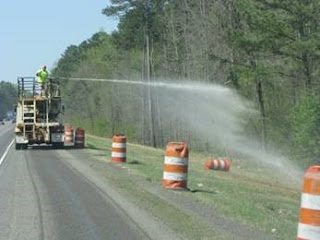Today’s Erosion and Sediment Control Tip: #20
When using hydroseeding equipment to apply seed, fertilizer, lime, hydromulch or hydraulic erosion control product, how do you know when you have achieved a uniform coverage? Some products have color (green) that can let you know what areas have been covered, but doesn’t tell you if the application is uniform. This picture clearly shows that most of the product goes to the outermost part of the “throw” from this type nozzle. It is most important for seed, fertilizer, lime and other products to be uniformly applied to be successful. The best way is to always use an experienced nozzle operator and driver because it requires teamwork. DON’T PUT THE “NEW GUYS” DOING THIS. Also, whenever possible, calculate the coverage area for the hydroseeder volume and mark that area on the ground. Product should be applied in at least 2 different directions on every site when possible and the tank emptied on the marked area. Nozzle operators and drivers should drive or look over the site together prior to hydroseeding the area. This allows the team to observe the limits of the area to be seeded including any wide areas which will require a reduction in speed of the truck, wind direction and speed, choose which nozzle to use for the conditions, and to look for obstacles such as low hanging wires and tree limbs that could endanger the operator. It is only after the team has made this observational trip that the hydroseeder is loaded with seed, fertilizer, etc. and the work begins. If necessary to communicate while working, the hydroseeder has a horn button on the control panel that the operator can use to signal the driver with pre-arranged signals to speed up, slow down or stop.
A hydroseeder is a valuable tool to achieve vegetative coverage on difficult surfaces, but use the tool wisely.
(Thanks to John Wolery of Championship Enterprises Inc. for his thoughts on this tip.)
Perry L.
Oakes, PE
Erosion & Sediment Control Program Coordinator
Alabama Soil and Water Conservation Committee




Comments